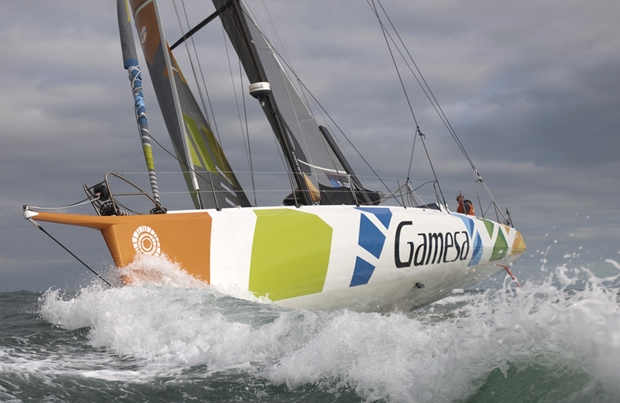
Back in the IMOCA 60
While it might not seem that long, the Transat Jacques Vabre marks Mike Golding’s return to the IMOCA 60 class after an absence of two years. With the sad death early last year of his long term backer Jørgen Philip-Sørensen, so Golding’s sponsorship from Ecover came to an end after two seasons spent catamaran racing on the Extreme Sailing Series. Over this winter his Owen Clarke-designed IMOCA 60, the former Ecover 3, was chartered to French legend Jean le Cam for the Barcelona World Race. Renamed Président, unfortunately she dismasted ten days into the race.
However Golding is now back in the class he has been involved with for the last 14 years, with a new sponsor in the form of Spanish wind turbine manufacturer Gamesa with a program that will take him through next year’s Vendee Globe and will hopefully see him better his third place result from the 2004-5 singlehanded non-stop round the world race.
His boat has been through a substantial rebuild at Green Marine and in particular there are now marked differences in the cockpit and in the cabintop, while the small section rotating mast that originally featured on the boat (and on Ecover 2) has been replaced with a more substantial fixed rig from Future Fibres.
While many of the last generation IMOCA 60s featured larger cockpits with more emphasis on racing doublehanded and occasionally fully crewed, so Gamesa’s new cockpit is an example of the trend back towards more compact layouts, better suited to singlehanding in the Vendee Globe. A double benefit of this is significant weight reduction. In Gamesa’s new cockpit, gone, for example, are the twin wheels and one of the two pedestals, in favour of a tiller. In fact the whole steering mechanism is new – the original quadrant replaced with levers which are “simpler and lighter” says Golding.
The main sheet track has been moved from atop the transom further forwards. The beam/bulkhead beneath the track was slotted in under the sidedecks in order not to cut into the carbon U-Ds running along the cockpit sidedecks. Forward in the cockpit two winches have been dispensed with, along with the winch on the mast – all lines now running aft to the cockpit, where there are just four winches.
The panel that enclosed the rear of the cockpit has been removed and in its place are simply stanchions, the tower for the various antennae removed too. As Golding says: “We stripped quite a lot of weight out of the back of the boat. We had pushpits, now we have straight stanchions. We used to have a big stack, but we simplified it and put the antennae down low.” The dome for the Fleet Broadband satcom antenna is now enclosed by its own hump in the deck, situated immediately forward of the mast, centralising its weight.
Very stealth bomber in its looks, the new cabintop is has very much less volume than the old one and features a narrow forward end, with side extensions further aft fitted with windows allowing the helmsman a view forward, with lines running back beneath to the twin pit areas. The V-shaped tiller has retractable extensions so the helmsman can steer while being shelter under the cabintop. A sliding hatch encloses the central part of the cockpit.
With substantial weight removed from the hull following the latest modifications, so they have been able to chop 185kg of lead from the keel, resulting in a giant leap down the weight spiral. From a displacement of around 8,300kg, now she is just over 8,000, “but the power of the boat remains the same. We feel the boat is more lively and slightly stiffer, because the CoG is lower.”
As to the new rig, Golding says that he was one of the first to work with Future Fibres when they set up their new mast building division. He tried to persuade Jean le Cam to change the boat’s rotating rig to a fixed mast, but fired up the project once again after the rig came down in the Barcelona World Race. With statistically more wingmasts toppling that fixed masts, Golding has reverted to the conservative option. “Two or three spreaders? We’ll have three please!”
With the new rules limiting mast height to an air draft of 29m, so the new mast has grown a little compared to its predecessor and the aspect ratio of the sails has been increased in turn. “All the sail plan has gone up: the genoa has gone to the top bar 300mm, so more or less masthead, the Solent has gone right up, the staysail has gone up to nearly where the Solent was. So we have more sail area on every single sail and we have inserted an ORC which we didn’t have before. Everything is right to the wire now, like the new boats,” explains Golding.
The rig is held in place by Future Fibres continuous carbon fibre shrouds resulting in very low drag spreader tips, the Vs and Ds adjusted within the mast. “Everything is very clean on the outside,” states Golding.
In the process of the mods, Gamesa has also been remoded. “The wing [mast] we had was an upwind solution. We are more optimised now for reaching and running and less for upwind, but on the other hand we have a lot of water ballast on this boat, so we can change our style of sailing quite significantly.”
The mast is stepped a little further aft compared to where the old mast sat. However returning to a more conventional format rig, they have had to fit chainplates for the D1s and these are inboard (while the V1 chainplates are outboard) to enable overlapping headsails to be sheeted between them.
Further weight has been saved by removing the jib sheet tracks in favour of the now universally popular flying ring system.
Down below the layout remains similar to before. Golding prefers a few creature comforts such as a proper chart table and a full width bench that cants. This bench is also mounted on a fore and aft track allowing it to be slid beneath the chart table during stacking or when access to the engine is required. The only difference the new coachroof makes to the interior is that headroom over the chart table area is substantially more restricted.
Gamesa, like all of the IMOCA 60s, has the potential to bring on board huge amounts of water ballast into tanks in the aft, centre and forward compartments. However Golding says they are using their front ballast less and less. “If you start slamming, you put the front in just to steady the boat down. It doesn’t make the boat go faster, but it feels nicer.”
In terms of Gamesa and her crew's prospects in the Transat Jacques Vabre - he is once again sailing with the legendary Bruno Dubois of North Sails France - Golding says he doesn’t really know about the newer boats. Before the latest modifications they were always competitive against the VPLP-Verdier designs Groupe Bel and Safran, and despite the latter’s new titanium keel foil, Golding feels they haven’t made as wholescale modifications to their boats as he has.

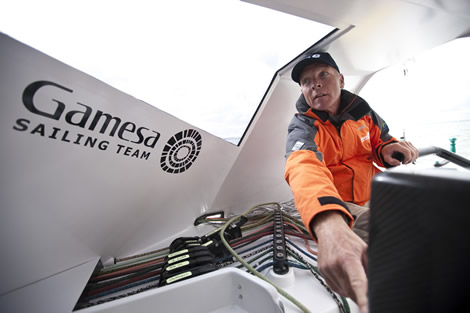
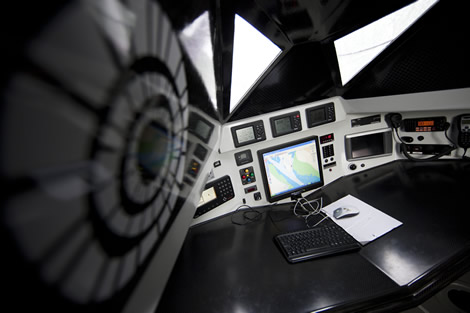
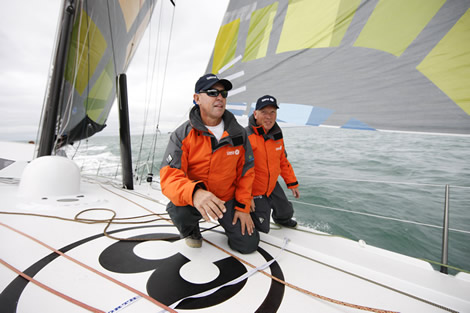
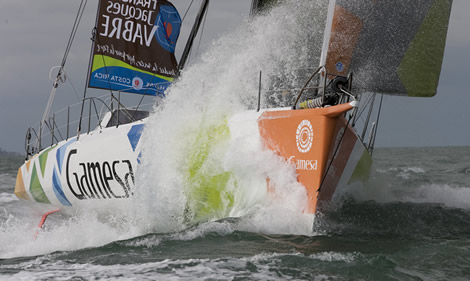
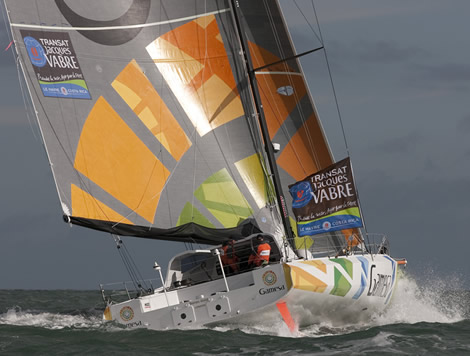
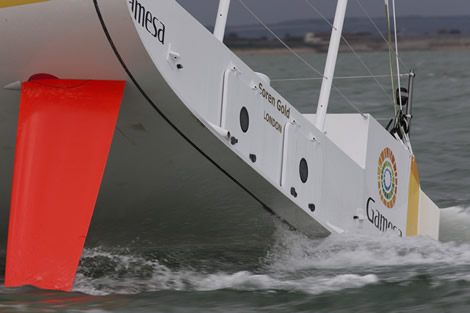
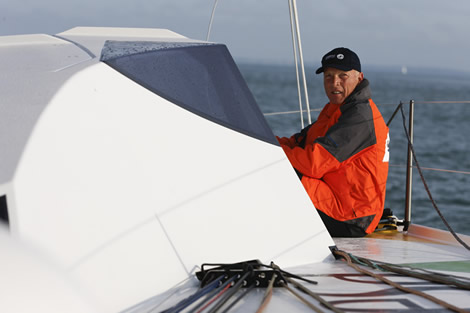
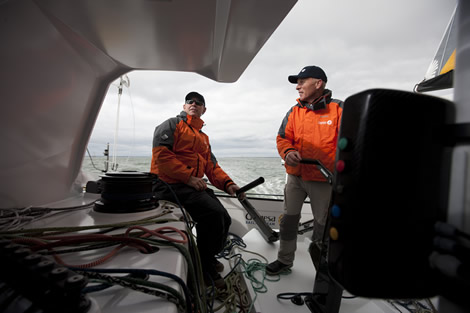









Latest Comments
seahorse 03/11/2011 - 17:09
Fine effort Mike. Good luck in the TJV matey. Andrew Hurst738272 02/11/2011 - 03:57
yes Mike, sweet boat. I like the changes. I'd love to sail her ! an Op[en 60 is the only step beyond my new rules Canoe that interests me! cheers, KennyAdd a comment - Members log in